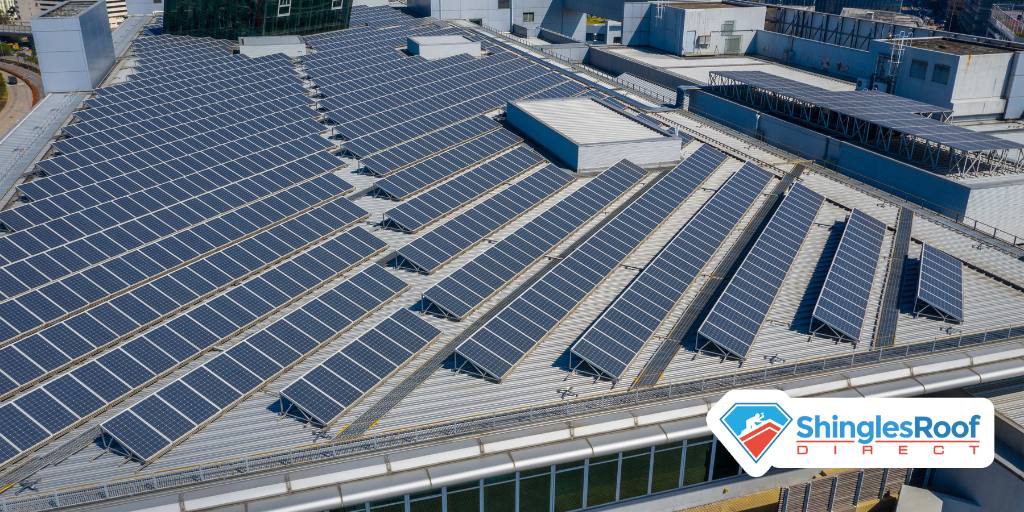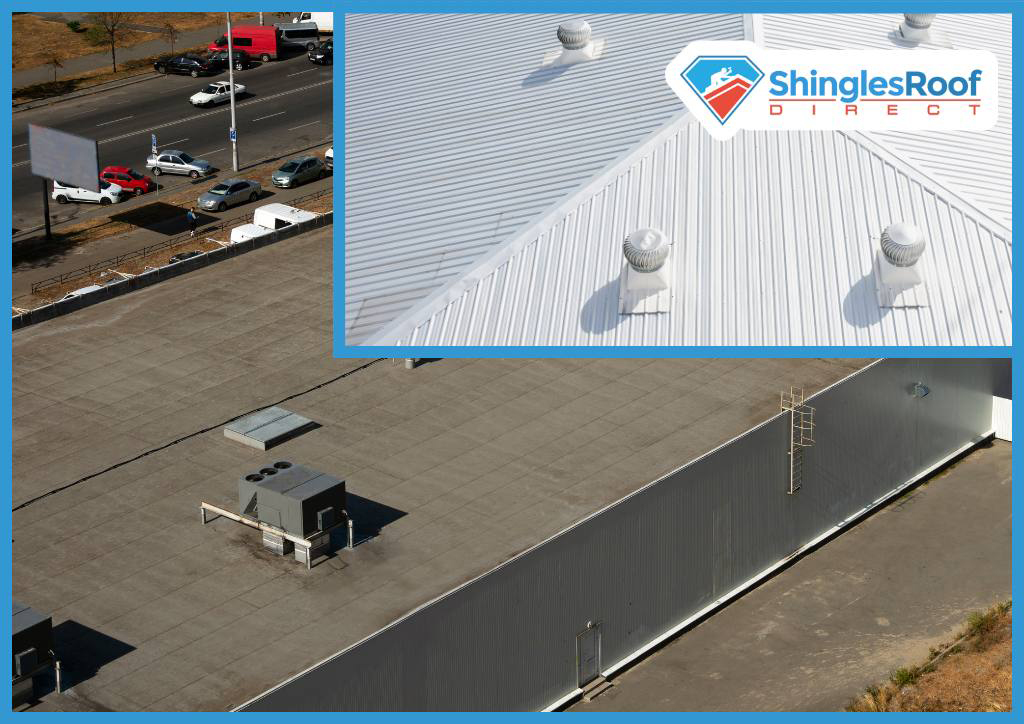Created by Microhound
Commercial roof replacement is a significant investment affecting both the financial and operational aspects of a business. Proper budgeting is essential to allocate funds appropriately and avoid unexpected expenses. It also maximizes ROI by enabling the selection of high-quality materials and contractors. It ensures compliance with safety regulations to avoid fines, and maintains operational continuity by scheduling the project to minimize disruptions.
When budgeting for a commercial roof replacement, several factors need to be considered for a comprehensive and accurate financial plan. These factors are what we will present in this new article of Shingles Roof Direct, to assist businesses in their decision-making process of roof replacement.
Table of Contents
Assessing the Current Roof Condition
Conducting a Thorough Roof Inspection
Hiring a Professional: Engage a certified roofing company to perform a detailed assessment. Professionals have the expertise to identify subtle issues that might be overlooked in a casual inspection.
Inspection Checklist: Ensure the inspection covers all aspects of the roof, including the surface material, underlying structure, flashing, gutters, and any rooftop equipment. Documenting findings with photographs and notes will help in understanding the extent of the damage and planning the replacement process.
Identifying Signs of Damage and Wear
Visual Indicators: Look for obvious signs of damage such as missing, cracked, or curling shingles; blisters or bubbles on the roof surface; and visible cracks or splits. These indicators often point to underlying problems that require attention.
Water Damage and Leaks: Check for water stains on the ceiling, mold growth, and damp insulation, which indicate potential leaks. Inspect the attic or top floor for any signs of water intrusion.
Structural Integrity: Evaluate the roof’s structural components, such as the decking and support beams, for sagging or other signs of compromise. Pay special attention to areas around chimneys, vents, and skylights, as these are common points for leaks and damage.
Wear and Tear from Environmental Factors: Assess the impact of weather-related wear, such as wind damage, hail impact, and UV radiation, which can degrade roofing materials over time.
Considering the Age of the Roof
Expected Lifespan of Roofing Materials: Different roofing materials have varying lifespans. For example, asphalt shingles typically last 20-25 years, while metal roofs can last 40-70 years. Knowing the age of your roof relative to the expected lifespan of its materials determines whether a replacement is necessary.
Historical Maintenance Records: Review the roof’s maintenance history to identify any recurring issues or repairs that might indicate systemic problems. A history of frequent repairs can signal that the roof is nearing the end of its useful life.
Warranty: Check if the roof is still under any warranty, which might cover certain types of damage and reduce replacement costs. Understanding the terms of the warranty can also guide the decision on timing for replacement.
Determining the Scope of the Replacement
Full Replacement vs. Partial Replacement
A full roof replacement involves removing the existing roofing system down to the deck and installing a new roof across the entire surface. It is recommended if the roof has widespread damage or has reached the end of its lifespan. Full commercial roof replacement can also be ideal for upgrading to more durable or energy-efficient materials. Although more expensive upfront, a full replacement can be cost-effective in the long run by reducing maintenance costs and increasing the roof’s lifespan.
Meanwhile, partial replacement replaces only the damaged sections of the roof while leaving intact areas untouched. This offers a more economical and faster solution. It’s advisable when damage is localized, such as from a tree falling or wind damage. It can also be considered when the majority of the roof is still in good condition with remaining useful life. While initially less expensive than a full replacement, it may lead to uneven wear and future issues if the remaining sections deteriorate at a different rate.
Identifying Specific Areas That Need Attention
During damage assessment, the roof inspection results should be used to identify specific areas for replacement. This should focus on sections with visible damage, leaks, or structural weakness. Additionally, it’s crucial to give extra attention to high-risk zones like around roof penetrations, edges, and valleys where water tends to accumulate and cause damage. Areas with a history of frequent repairs should be also carefully considered, as this may indicate underlying issues requiring a more extensive replacement.
Consulting with a Roofing Professional
When consulting with a roofing professional, it’s essential to engage a qualified contractor to evaluate the roof’s condition thoroughly. They can provide insights into whether a full or partial replacement is more suitable based on their expertise. Request detailed estimates for both options, so you will have breakdowns of materials, labor, permits, and disposal fees. Rely on the professional’s recommendations for the best course of action. They can offer guidance on cost-effective and durable solutions for the building’s needs and operations.
Estimating Costs
Cost of Materials
Different Types of Roofing Materials: When budgeting for a commercial roof replacement, it’s important to consider the cost of various roofing materials available in the market, such as Thermoplastic Polyolefin (TPO), Ethylene Propylene Diene Terpolymer (EPDM), metal, asphalt, and built-up roofing (BUR). Each material type comes with its advantages and disadvantages in terms of durability, energy efficiency, and cost-effectiveness.
Pros and Cons of Each Material Type: TPO is known for its durability and energy efficiency, EPDM offers affordability and easy installation, while metal roofing provides longevity and low maintenance. However, each material has its drawbacks, such as TPO’s susceptibility to punctures, EPDM’s vulnerability to UV radiation, and metal roofing’s higher initial cost.
Labor Costs
Roofing contractors typically charge either hourly rates or project rates for labor. Hourly rates may be preferable for smaller projects or repairs, while project rates are more common for larger-scale roof replacements. Project rates provide more predictability in costs and incentivize contractors to complete the job efficiently.
Labor costs for roof replacement can also vary depending on the season. In regions with harsh winters or rainy seasons, labor costs may increase due to weather-related challenges and decreased productivity. Planning the replacement during off-peak seasons can help prevent these cost variations.
Additional Costs
Permits and Inspections: Factor in the cost of obtaining permits and undergoing inspections required by local building codes and regulations. Permit fees vary depending on the jurisdiction and the scope of the project, while inspections ensure compliance with safety standards and may incur additional fees.
Waste Disposal and Cleanup: Proper disposal of old roofing materials and debris is necessary during a roof replacement project. Include the cost of waste disposal services and cleanup efforts in the budget to ensure a clean and safe work environment.
Timing and Scheduling
Spring and fall, with mild temperatures and lower precipitation, are ideal for replacements, avoiding extreme weather that compromises project quality. Coordinating with business operations is essential to minimize disruptions, scheduling replacements during periods of low activity like weekends or holidays.
Additionally, contingency planning is important to address weather-related delays. This involves flexibility in scheduling to accommodate rescheduled workdays and clear contractual agreements with the roofing contractor. An emergency response plan ensures worker safety and project continuity during severe weather events. It emphasizes protocols for evacuating the work site and resuming work once conditions improve.
Long-Term Considerations
Energy Efficiency and Insulation
Investing in energy-efficient roofing materials and insulation can lead to significant cost savings over the long term. Materials such as cool roofs, which reflect sunlight and heat away from the building, can help lower indoor temperatures and decrease the demand for air conditioning during hot summer months. Proper insulation can also improve thermal performance, minimize heat transfer, and maintain comfortable indoor temperatures year-round.

Maintenance and Warranty Considerations
Regular maintenance is essential for prolonging the lifespan and performance of a commercial roof. When planning a replacement, businesses should consider the ease of maintenance and the availability of warranty coverage for the new roofing system. Many roofing companies offer warranties that cover defects in materials and workmanship for a specified period. Implementing a proactive maintenance plan, such as regular inspections and repairs, can help identify and address issues early. It can also prevent costly damage and preserve the roof’s integrity over time.
Future-Proofing and Scalability
Businesses should assess factors such as anticipated growth, technological advancements, and changing industry regulations when selecting roofing materials and designs. Scalability is also essential, as businesses may require modifications or expansions in the future that impact the roof’s functionality and performance. Flexible roofing solutions, such as modular designs or systems that allow for easy upgrades and additions, can help accommodate future changes without requiring extensive renovations or replacements.
Is it time for your commercial roof replacement?
A commercial roof replacement requires careful planning and consideration of various factors to ensure a successful outcome. Throughout this guide, we discussed the things to keep in mind when budgeting, assessing, and scheduling a commercial roof replacement. Assessing the current roof condition thoroughly is crucial to determine the extent of the replacement needed. Determining also the scope of the replacement, whether full or partial, depends on factors like the age of the roof and the severity of damage. Further, timing and scheduling the replacement can minimize disruptions to business operations and ensure optimal weather conditions for the project.
As you embark on your commercial roof replacement, here are some final tips to ensure a smooth and cost-effective process. Firstly, prioritize safety by hiring reputable contractors with the qualifications and insurance coverage. Secondly, communicate openly and regularly with employees, tenants, and contractors, to manage expectations and minimize disruptions. Thirdly, invest in high-quality materials and consider energy-efficient options to maximize long-term savings and sustainability. Lastly, implement a proactive maintenance plan to preserve the roof’s integrity and longevity after the replacement. By following these tips, you can navigate the roof replacement process successfully and ensure a durable and efficient roofing solution for your business.
Quick FAQs on Commercial Roof Replacement
What factors should I consider when budgeting for a commercial roof replacement?
When budgeting for a commercial roof replacement, several factors should be taken into account, including the size and complexity of the roof, the type of materials needed, labor costs, any additional expenses such as permits and inspections, and potential hidden costs like structural repairs. It’s essential to conduct a thorough assessment of the current roof condition and consult with roofing professionals to determine the scope of the replacement accurately.
How can I determine if a full or partial roof replacement is necessary for my commercial building?
The decision between a full or partial roof replacement depends on various factors, including the extent of damage, the age of the roof, and budget constraints. A full replacement involves replacing the entire roofing system down to the deck, while a partial replacement targets specific damaged areas. Consulting with a qualified roofing contractor and conducting a detailed inspection can help assess the condition of the roof and determine the most appropriate course of action.
What are some cost-effective roofing materials for a commercial roof replacement?
Several cost-effective roofing materials are available for commercial roof replacements, including TPO (Thermoplastic Polyolefin), EPDM (Ethylene Propylene Diene Terpolymer), and modified bitumen. These materials offer durability, weather resistance, and energy efficiency at relatively affordable prices compared to traditional options like metal or asphalt. Consulting with roofing professionals can help determine the best material choice based on your budget and specific requirements.
Created by Microhound

